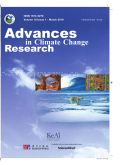- 钛学术文献服务平台 \
- 学术期刊 \
- 基础科学期刊 \
- 天文学、地球科学期刊 \
- 气候变化研究进展(英文版)期刊 \
Sensitivity analysis of standardized precipitation index to climate state selection in China
Sensitivity analysis of standardized precipitation index to climate state selection in China
基本信息来源于合作网站,原文需代理用户跳转至来源网站获取
摘要:
In the calculation of the standardized precipitation index (SPI) index,it is necessary to select a certain period of precipitation samples as the reference climate state,and the SPI obtained by different reference climate states have different size.Therefore,the influence of different reference climate states on the accuracy of SPI calculation is worth analyzing.Based on the monthly precipitation data of 1184 stations in China from 1961 to 2010,the influence of the selection of the reference climatic state in the calculation of SPI was analyzed.Using 30 consecutive years as the duration of the reference climatic state,1961-2010 is divided into three periods 1961-1990,1971-2000,1981-2010.Taking the SPI obtained from the entire period as the standard value,the spatial distribution of SPI error and the accuracy of SPI classification based on each reference period were analyzed.Then,the resampling method was used to analyze the influence of time-continuous precipitation samples on the size of SPI.The results show that the SPI error of most sites is less than 0.2,and the accuracy of SPI classification is more than 80%.Although the errors of SPI mostly come from extreme drought and extremely wet,this does not affect the accuracy of the recognition of extreme drought and extremely wet.In most regions,it is reliable to calculate SPI based on the precipitation data of continuous 30 years,but the reliability of SPI is relatively low in areas with frequent drought.The results of the resampling analysis and 30-year sliding analysis show that the distribution parameters have noticeable turning characteristics,and the precipitation distribution parameters of nearly 85% stations had noticeable turning point before 1985,which led to the precipitation data of continuous 30 years easily overestimate the dry/wet.

推荐文章
State of rare earth elements in the rare earth deposits of Northwest Guizhou, China
Kaolinite
Clay rocks
Rare earth deposits
Element existence state
Information extraction
Northwest Guizhou Province
The influence of climate and topography on chemical weathering of granitic regoliths in the monsoon
Granitic regolith
Chemical weathering
Supply-limited weathering
Kinetic-limited weathering
Ecological stoichiometry of nitrogen, phosphorous, and sulfur in China's forests
Forest
Stoichiometry
Nitrogen
Phosphorous
Sulfur
China
Test the topographic steady state in an active mountain belt
Taiwan
Uplift
Denudation
River profile
Sediment yield
In-situ 10Be
内容分析
关键词云
关键词热度
相关文献总数
(/次)
(/年)
文献信息
| 篇名 | Sensitivity analysis of standardized precipitation index to climate state selection in China | ||
| 来源期刊 | 气候变化研究进展(英文版) | 学科 | |
| 关键词 | |||
| 年,卷(期) | 2022,(1) | 所属期刊栏目 | Changes in climate system |
| 研究方向 | 页码范围 | 42-50 | |
| 页数 | 9页 | 分类号 | |
| 字数 | 语种 | 英文 | |
| DOI | |||
五维指标
引文网络
引文网络
二级参考文献 (0)
共引文献 (0)
参考文献 (0)
节点文献
引证文献 (0)
同被引文献 (0)
二级引证文献 (0)
2022(0)
- 参考文献(0)
- 二级参考文献(0)
- 引证文献(0)
- 二级引证文献(0)
引文网络交叉学科
相关学者/机构
期刊影响力
气候变化研究进展(英文版)
主办单位:
国家气候中心
出版周期:
季刊
ISSN:
1674-9278
CN:
11-5918/ P
开本:
16开
出版地:
北京市中关村南大街46号国家气候中心
邮发代号:
创刊时间:
2010
语种:
eng
出版文献量(篇)
377
总下载数(次)
0
总被引数(次)
708
期刊文献
相关文献
推荐文献
- 期刊分类
- 期刊(年)
- 期刊(期)
- 期刊推荐
力学
化学
地球物理学
地质学
基础科学综合
大学学报
天文学
天文学、地球科学
数学
气象学
海洋学
物理学
生物学
生物科学
自然地理学和测绘学
自然科学总论
自然科学理论与方法
资源科学
非线性科学与系统科学
气候变化研究进展(英文版)2022
气候变化研究进展(英文版)2021
气候变化研究进展(英文版)2020
气候变化研究进展(英文版)2019
气候变化研究进展(英文版)2018
气候变化研究进展(英文版)2017
气候变化研究进展(英文版)2016
气候变化研究进展(英文版)2015
气候变化研究进展(英文版)2014
气候变化研究进展(英文版)2013
气候变化研究进展(英文版)2012
气候变化研究进展(英文版)2011
气候变化研究进展(英文版)2010

 免费查重
免费查重










